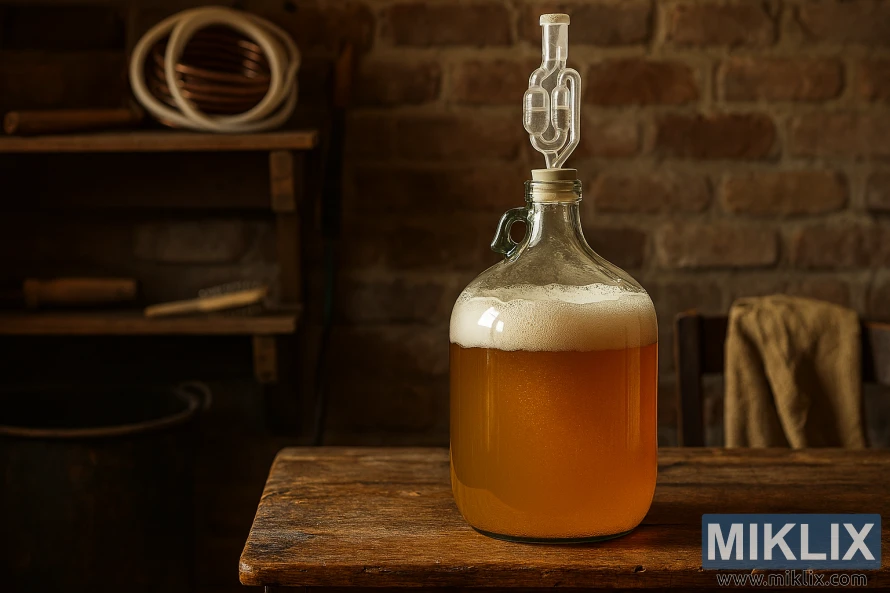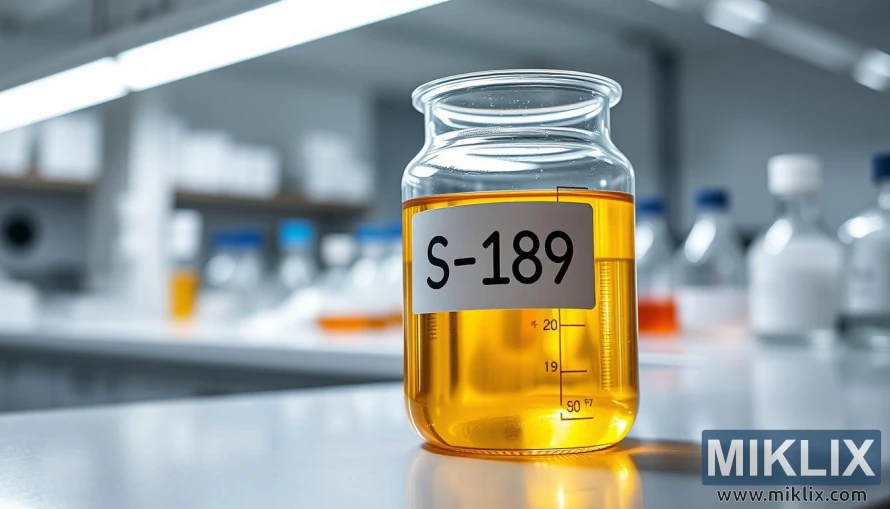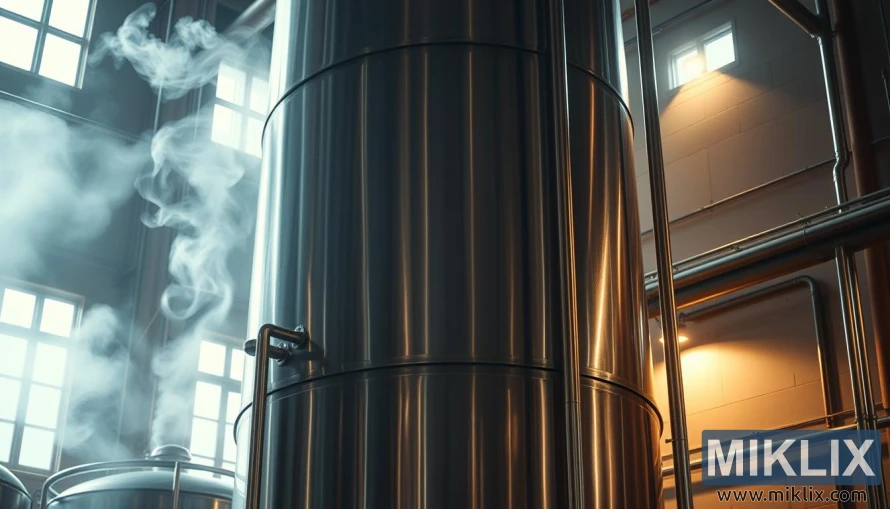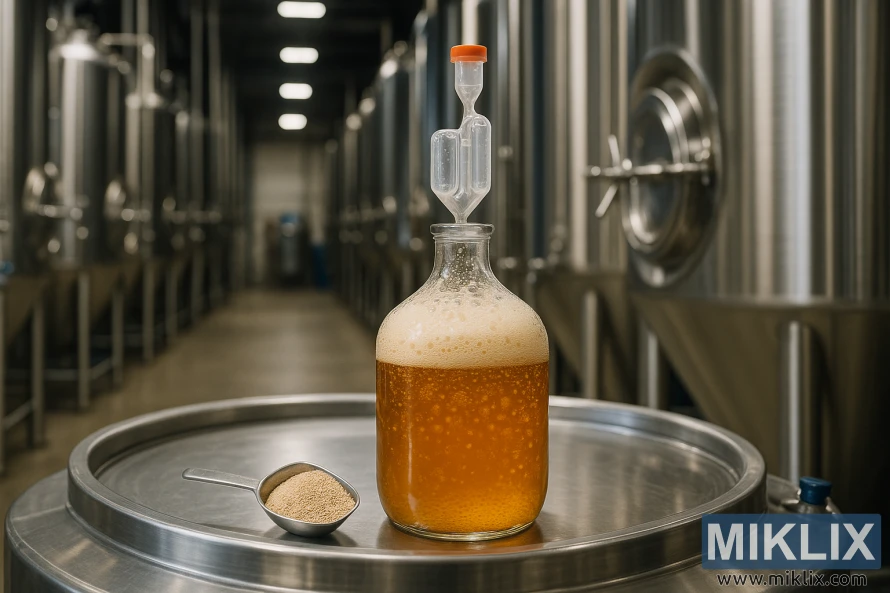Fermenting Beer with Fermentis SafLager S-189 Yeast
Published: August 17, 2025 at 6:46:33 PM UTC
Last updated: November 27, 2025 at 2:00:44 PM UTC
Fermentis SafLager S-189 Yeast, a dry lager yeast, has its roots at the Hürlimann brewery in Switzerland. It is now marketed by Fermentis, a Lesaffre company. This yeast is perfect for clean, neutral lagers. It ensures a drinkable and crisp finish. Homebrewers as well as small commercial brewers will find it useful for Swiss-style lagers and various pale, malt-forward lager recipes.

This yeast is available in sizes ranging from 11.5 g to 10 kg. Fermentis S-189 offers flexible dosing for single batches up to pilot-scale production. The ingredient list is simple: yeast (Saccharomyces pastorianus) with emulsifier E491. The product carries the E2U™ label. This review focuses on its technical performance, sensory expectations, and practical pitching guidance for U.S. brewers.
Key Takeaways
- Fermentis SafLager S-189 Yeast is a dry lager yeast suited for clean, neutral lagers.
- Originates from Hürlimann and is marketed by Fermentis / Lesaffre.
- Available in multiple package sizes, from 11.5 g to 10 kg.
- Ingredients: Saccharomyces pastorianus and emulsifier E491; labeled E2U™.
- Ideal for homebrewers and small pro brewers seeking a highly drinkable lager profile.
Why Choose Fermentis SafLager S-189 Yeast for Your Lagers
Fermentis SafLager S-189 is celebrated for its clean, neutral profile. It highlights malt and hop flavors, making it ideal for those seeking a drinkable lager. This yeast minimizes fruity esters, ensuring a crisp finish.
When fermentation conditions are just right, it reveals subtle herbal and floral notes. These aromatics are perfect for styles like Vienna lagers, Bocks, and Oktoberfests. It's the choice for clarity without sacrificing nuance.
Dry-form stability makes S-189 easy to store and pitch. Lesaffre’s high standards ensure consistent performance and microbiological purity. This reliability is a boon for both commercial brewers and serious homebrewers who value repeatable results.
- Flavor goal: clean base with slight herbal or floral hints
- Best for: Swiss-style lagers, Bocks, Oktoberfests, Vienna lagers
- Practical edge: stable dry yeast with consistent attenuation
For recipes needing a neutral base, S-189 is a better choice than more expressive strains like Hürlimann yeast. It produces a beer that's highly drinkable yet offers subtle complexity when desired.
Technical Specifications and Packaging Options
Fermentis offers detailed S-189 technical data for brewers. The viable cell count is over 6.0 × 10^9 cfu/g. This ensures consistent fermentation and reliable yeast viability.
Purity standards are high: purity exceeds 99.9% with minimal microbial contaminants. The limits include lactic acid bacteria, acetic acid bacteria, and Pediococcus at under 1 cfu per 6.0 × 10^6 yeast cells. Total bacteria and wild yeast are also strictly controlled.
Shelf life is 36 months from production. Storage is straightforward: keep below 24°C for up to six months, and below 15°C for longer storage. Once opened, sachets should be resealed and stored at 4°C. Use within seven days to maintain yeast viability.
Fermentis packaging meets various needs. Available sizes range from 11.5 g to 10 kg. These options cater to hobbyists and large-scale brewers, ensuring the right dose for each batch while preserving dry yeast specs.
- Viable cell count: > 6.0 × 109 cfu/g
- Purity: > 99.9%
- Shelf life: 36 months from production
- Packaging sizes: 11.5 g, 100 g, 500 g, 10 kg
Regulatory labeling identifies the product as E2U™. A technical data sheet is available for lab metrics. Brewers can plan dosing, storage, and quality control. This ensures consistent yeast viability and performance.
Fermentation Performance and Attenuation
S-189 attenuation has shown impressive results in various trials. Data and user feedback indicate an apparent attenuation of 80-84%. This means that when fermentation is complete, the final gravity is quite dry, under the right conditions.
The fermentation kinetics of this strain are solid across different lager temperatures. Fermentis conducted tests starting at 12°C and ending at 14°C. They measured residual sugars, flocculation, and alcohol production. It's essential for brewers to conduct bench trials to align these kinetics with their wort and schedule before scaling up.
The flavor impact of S-189 is generally clean. Tests showed low levels of total esters and higher alcohols. This supports a neutral flavor profile, perfect for classic lagers or beers with a strong malt character.
Alcohol tolerance is another area where S-189 stands out. Informal tests and brewer feedback suggest it can handle alcohol levels beyond the typical lager range. For instance, it can reach up to 14% in high-gravity beers or when restarting stuck ferments. Fermentis emphasizes its suitability for standard lager brewing.
When working with S-189, pay close attention to pitching method and oxygenation. To achieve consistent fermentation kinetics and the desired attenuation of 80-84%, controlling temperature and nutrients is key.
- Run a small-scale trial to verify S-189 attenuation in your wort.
- Monitor gravity frequently to map fermentation kinetics.
- Plan for higher alcohol scenarios if you push gravity; alcohol tolerance may help finish tough ferments.
Recommended Dosage and Temperature Ranges
Fermentis suggests using 80 to 120 g of S-189 per hectoliter for standard lager fermentations. For those brewing at home, adjust the sachet size according to your batch volume. An 11.5 g sachet is only suitable for a small fraction of a hectoliter. So, calculate the amount needed to achieve the desired cell count.
The pitch rate is critical for a clean fermentation. It helps manage ester production and diacetyl cleanup. For 5-gallon ales and lagers, adjust the S-189 dosage to match the desired cell count. This approach ensures a clean fermentation, regardless of the sachet size.
For optimal results, keep the S-189 fermentation temperature between 12°C and 18°C (53.6°F–64.4°F). This range is essential for achieving a clean lager profile. It supports steady attenuation and predictable flavor development during primary fermentation.
Homebrewers can achieve acceptable results by running S-189 slightly warmer, in the mid-60s to low-70s °F (about 18–21°C). This flexibility is useful when lagering capacity is limited. Yet, expect more noticeable esters and a less classic lager profile at higher temperatures. Use this flexibility with caution, understanding the trade-offs involved.
After primary fermentation, lagering and cold conditioning should follow at the recommended S-189 fermentation temperature. Once attenuation is complete, drop to traditional cold-conditioning temperatures. This step improves clarity and refines flavor before packaging.
- Dosage guideline: 80–120 g/hl; convert to batch size for accurate pitching.
- Pitch rate: match cell count to wort gravity and batch volume for consistent results.
- Primary S-189 fermentation temperature: 12–18°C (53.6–64.4°F) for clean lagers.
- Flexible option: 18–21°C (mid-60s to low-70s °F) for homebrewers without lagering facilities; expect ester variation.

Pitching Options: Direct Pitching and Rehydration
Fermentis SafLager S-189 presents two dependable pitching methods. Many brewers opt for direct pitch dry yeast for its simplicity and speed. Sprinkle the yeast gradually onto the wort's surface at or slightly above the target fermentation temperature. This approach helps the yeast distribute evenly, reducing clumping and ensuring uniform fermentation.
For those who prefer a more gentle start, a rehydration protocol is available. Sprinkle the sachet into at least ten times its weight of sterile water or cooled, boiled wort at 15–25°C (59–77°F). Allow the cells to rest for 15–30 minutes before gently stirring to create a creamy slurry. Then, pitch the yeast cream into the fermenter to minimize shock and enhance viability.
Fermentis dry strains exhibit remarkable resilience without rehydration. The yeast handling guidelines allow for cold or direct pitching without significant loss of viability or kinetics. This adaptability makes direct pitch dry yeast ideal for smaller batches or when there's no access to lab equipment or sterile water.
- Avoid extreme temperatures when rehydrating to reduce osmotic or thermal shock.
- Do not add dry yeast to boiling wort; target the recommended temperature window for best vitality.
- When using the direct pitch method, distribute yeast across the wort surface for even inoculation.
Effective yeast handling enhances fermentation predictability. Adhere to the manufacturer's guidance, tailor the rehydration protocol to batch size, and consider starter or higher pitch rates for high-gravity beers. These measures ensure SafLager S-189 reaches its full performance with minimal risk.
Flocculation, Sedimentation, and Conditioning
S-189 flocculation is known for its reliable yeast drop-out after primary fermentation. Fermentis provides a detailed technical profile, including sedimentation time. This allows brewers to confidently plan a standard lager timeline.
Expect a clear trub layer and consistent sedimentation time, which supports typical lager conditioning. Once attenuation is complete, yeast and protein will compact. This leaves the wort ready for cold storage and slow maturation.
Cold lagering enhances beer clarity by allowing residual particles to settle. Maintain temperatures near 33–40°F for several weeks. This sharpens flavor and encourages further sedimentation before packaging.
- Handle opened sachets with care; refrigeration keeps viability for about seven days.
- Repitch only fresh, properly stored yeast to avoid reduced flocculation performance.
- Use gentle racking to avoid disturbing settled yeast and trub.
Head retention is influenced more by grain bill and adjuncts than yeast alone. High-protein malts and certain wheat or oats improve foam stability more than yeast differences.
For predictable lager conditioning, combine consistent cooling with time. Proper cold storage and patient maturation lead to the best beer clarity. S-189 flocculation ensures a clean, bright lager.
Sensory Outcomes: What to Expect in Finished Beer
The sensory impressions of Fermentis SafLager S-189 highlight a balanced flavor profile. Brewers note minimal esters and moderate higher alcohols. This results in a clean lager character, where malt and hops take center stage.
Under specific fermentation conditions, brewers might detect herbal notes. These occur when the fermentation temperature, pitch rate, or oxygen management deviate from traditional lager practices. The herbal notes introduce a subtle complexity to malt-forward styles.
Floral notes, though less common, can appear with slightly warmer lagering or when using delicate noble hops. When they do, floral notes are delicate and do not dominate the beer's essence.
Best suited for styles like Swiss lagers, Vienna lagers, Bocks, and sessionable lagers, S-189 enhances the clean lager character. In malt-driven beers such as Oktoberfest and classic bocks, it showcases rich malt flavors with restrained yeast aromatics.
Community tasting notes vary. Some appreciate S-189 for improving drinkability in malt-forward beers. Blind tests at lower ABV and standard lager processes often reveal little difference compared to other clean lager strains.
- Primary: neutral ester profile and low higher alcohols.
- Conditional: occasional herbal notes under specific conditions.
- Optional: light floral notes with warmer or hop-delicate approaches.
Comparing S-189 to Other Popular Lager Strains
Brewers often compare S-189 vs W34/70 and S-189 vs S-23 when selecting a strain for lagers. S-189 is known for its maltier profiles, making it a favorite for Bocks and Oktoberfests. On the other hand, W-34/70 is celebrated for its clean, crisp finish, ideal for traditional pilsners.
Temperature flexibility is key in practice. Community trials indicate S-189 and W-34/70 can ferment cleanly up to about 19°C (66°F) in many setups. Results can vary based on pitch rate and mash, making local tests essential.
WLP800 (Pilsner Urquell) stands out from S-189 and W-34/70, bringing a slight old-world bite and deeper pils character. Danstar Nottingham, an ale strain, is sometimes used for comparison. It ferments warmer and produces different esters, highlighting the restraint emphasized by lager strains.
When comparing lager yeasts, side-by-side batches on the same recipe reveal subtle differences. Some tasters struggle to tell strains apart in blind tests. This shows that process, water, and malt can influence results as much as yeast choice.
- S-189 vs W34/70: S-189 favors malt-forward lagers and performs well at slightly lower temps in many reports.
- S-189 vs S-23: S-23 may show a bit more neutral character; S-189 can give a gentle herbal or floral lift.
- Compare lager yeasts: run small-scale trials to see which strain matches your recipe and conditioning timeline.
For practical use, choose S-189 for a neutral but drinkable lager with subtle malt complexity. Opt for W-34/70 for a classic, crisp pilsner profile. Test identical recipes side-by-side for definitive results in your brewery or home setup.
Using Fermentis SafLager S-189 Yeast
Begin by aligning Fermentis dosing with your batch size. For standard lagers, use 80–120 g/hl. Homebrewers can adjust an 11.5 g packet based on batch size using the grams-per-hectoliter rule.
Choose between direct pitching and rehydration based on convenience and yeast health. Direct pitching is quicker and easier, while rehydration can boost initial vitality, essential for stressed worts.
Control fermentation temperature between 12–18°C for consistent attenuation. Maintain this range and monitor gravity daily to track progress and detect stalls early.
- Oxygenate wort at pitching to support a strong yeast start.
- Use a starter or larger pitched mass for high gravity lagers.
- Follow Fermentis recommendations when converting packet sizes to grams per hectoliter.
When pitching S-189, ensure even distribution across chilled wort. Stir gently after pitching to disperse cells and facilitate contact with oxygen.
For homebrewing lager tips, run small split batches before committing to larger runs. Trial batches help understand how S-189 performs in your system and refine lagering schedules.
Commercial operators should conduct lab-style trials and scale up stepwise. Keep records on attenuation, flocculation timing, and sensory notes to compare across fermentations.
Follow good sanitation, measure pitching rates carefully, and log oxygenation levels. These practices enhance consistency, allowing confident application of pitching S-189 across recipes.
S-189 in Special Applications and Edge Cases
Brewers experimenting with S-189 high gravity batches report the strain shows notable alcohol tolerance. Anecdotal accounts suggest it can push toward 14% ABV in well-fed worts when managed carefully. Formal Fermentis guidance centers on classic lager ranges, so trial batches are wise before scaling.
When faced with stuck fermentations, some brewers have used S-189 to restart activity. Gentle rousing, temperature increases within safe limits, and oxygen management can help the yeast recover. Expect slower cleanup of higher sugars compared with standard-strength lagers.
Ale-temperature lagering has become a practical option for brewers without cold storage. Community experiments fermenting S-189 in the mid-60s to low-70s °F yield acceptable beers with slight ester shifts. This method favors faster turnarounds while keeping a relatively clean lager profile.
S-189 suits malt-forward styles like Bocks and Oktoberfests where a sturdy, low-ester character supports malt complexity. Brewers note improved drinkability and a balanced finish when the yeast is pitched at recommended rates and given adequate nutrient support.
Experimental protocols such as pressure fermentation and low dissolved-oxygen workflows can benefit from S-189’s robustness. These edge-case approaches may reduce ester formation and tighten profiles, but controlled trials are essential to verify effects before production runs.
Re-pitching S-189 across multiple generations is common in craft setups, yet cell health must be monitored. Keep propagation sanitary, check viability, and avoid excessive generations to prevent off-flavors or stress-related fermentation issues.
- For high-gravity work: oxygenate thoroughly and consider staggered nutrient additions.
- For stuck fermentations: raise temperature slowly and avoid over-aeration late in fermentation.
- For ale-temperature lagering: expect subtle ester differences and plan conditioning time correspondingly.
- For re-pitching: track generation count and viability with simple lab checks.
Small-scale tests yield the most reliable insight when pushing S-189 beyond typical lager boundaries. Keep logs of pitch rates, gravity, temperature, and conditioning to refine protocols that fit your brewery or home setup.

Quality Control and Lab Data Insights
Fermentis publishes detailed S-189 lab data, focusing on microbiological purity and viability. These tests adhere to EBC Analytica 4.2.6 and ASBC Microbiological Control standards. They reveal low counts of lactic and acetic acid bacteria, Pediococcus, wild yeasts, and total bacteria.
The viable cell count for SafLager S-189 is over 6.0×10^9 cfu/g, under optimal storage and handling conditions. This high count ensures brewers have a reliable pitching mass. It also supports consistent fermentation across batches.
Lesaffre's quality control and group manufacturing lead to production benefits. Continuous process enhancements and traceable batch records ensure reproducible fermentation. They also support safety checks during yeast production.
Storage QA guidelines are in place to maintain long-term performance. The shelf life is 36 months, with specific storage rules. These rules include keeping the product below 24°C for up to six months. For longer storage, it should be below 15°C to preserve viability and purity.
Laboratory reports accompany each product lot, including microbiological screens and viability assays. Brewers can use these reports to confirm their QA plans' compliance. They can also compare S-189 lab data across different production runs.
- Analytical methods: EBC and ASBC protocols for microbial limits
- Viability target: >6.0×10^9 cfu/g
- Shelf life: 36 months with specific temperature controls
- Quality scheme: Lesaffre quality control across production
Thoroughly examining lab certificates is key to maintaining consistency in aroma and attenuation. Regular checks of microbiological purity and viable cell count are essential for breweries using SafLager S-189.
Recipe Ideas and Experimental Protocols
Consider a Vienna lager recipe, focusing on Munich and Vienna malts for a rich, toasty flavor. Use a light hand with Saaz hops. Mash temperatures between 64–66°C are key for a full-bodied beer. Ferment with SafLager S-189 at the cooler end of its range. This approach enhances the clean malt character while maintaining a subtle floral note.
For a bock, aim for a robust malt structure with Vienna, Munich, and caramel malts. Moderate noble hops and a long, cool conditioning period are essential. Oxygenation, nutrient additions, and a gentle fermentation ramp are vital for S-189's success with high-gravity beers.
Explore hybrid lagers like Munich Helles or Märzen with moderate gravities and subtle hop profiles. Opt for Willamette or American noble hops for a balanced flavor. Fermenting around 14°C can balance attenuation and ester levels.
- Split-batch comparison: brew one mash, split into three fermenters, pitch S-189, Wyeast W-34/70, and Safbrew S-23 to compare aroma and attenuation.
- Temperature trial: run identical grists at 12°C, 16°C, and 20°C to map ester production and finish.
- High-gravity protocol: oxygenate well, add yeast nutrients, and consider staggered sugar feeding or step increases of 2–3°C during active fermentation to protect yeast health.
Keep detailed records of gravity, pH, and sensory notes at regular intervals. Use consistent hopping and water profiles across trials to isolate yeast effects. Taste tests after diacetyl rest and after cold conditioning show S-189's evolution.
A well-structured experimental lager protocol should outline clear variables and repeatable measurements. Include a control strain for comparison. Note fermentation length, terminal gravity, and mouthfeel. These records are essential for refining S-189 recipes and high-gravity strategies.
Common Troubleshooting and Practical Tips
Small errors with dry yeast can cause significant problems during lager ferments. Always check sachets for softness or punctures before use. Discard any damaged Fermentis packages. Store unopened sachets in a cool, dry place. Once opened, refrigerate and use within seven days to minimize viability loss.
When rehydrating yeast, it's essential to control the temperature to avoid shock. Use sterile water or a small amount of cooled wort at 15–25°C. Allow the yeast to rest for 15–30 minutes, then stir gently before pitching. Avoid rehydrating at high temperatures and then adding to cold wort, as this can stress cells and introduce off-flavors.
Direct pitching also has its best practices. Sprinkle the dry yeast progressively across the wort surface to prevent clumping. Add the yeast while filling to allow it to warm gradually. This method reduces thermal and osmotic stress without the need for extra equipment.
If fermentation appears stuck, confirm the basic conditions first. Measure the gravity, check the fermentation temperature, and verify oxygenation and nutrient levels. S-189’s alcohol tolerance can help with stubborn beers. You may need to slowly raise the temperature or pitch an active starter of fresh yeast.
- Check oxygenation and dissolved oxygen before pitching in high gravity worts.
- Use yeast nutrient when working with limited malt extracts or adjuncts.
- Consider a fresh re-pitch if cells are old or viability is low.
Flavor control is largely dependent on maintaining consistent temperature. Stick to Fermentis recommended ranges to avoid unwanted herbal or floral notes. If you desire a warmer profile for character, plan this choice and monitor closely to avoid volatility.
Keep detailed records of pitching rates, rehydration method, and storage history for future S-189 troubleshooting. Clear logs help identify patterns and fix recurring dry yeast issues before they become fermentation stuck problems.
Conclusion
Fermentis SafLager S-189 stands out as a dependable choice in this S-189 summary. It boasts high attenuation (80–84%), minimal ester production, and a clean malt profile. This makes it ideal for both classic lagers and modern styles, providing a neutral base with occasional herbal or floral notes.
As a top contender for the best dry lager yeast, S-189 offers several advantages. Its dry yeast form is convenient, fermentation is predictable, and it tolerates a range of temperatures and alcohol levels. This versatility makes it perfect for malt-forward beers, commercial batches, and homebrew experiments where consistency is key.
To sum up Fermentis S-189 effectively, adhere to the recommended dosing (80–120 g/hl), follow storage and handling guidelines, and conduct small-scale trials in your cellar. Comparing it with strains like W-34/70 and S-23 will help you determine which suits your flavor preferences and brewing process best. Testing on a small scale ensures the yeast aligns with your recipes and brewing systems.

Further Reading
If you enjoyed this post, you may also like these suggestions:
- Fermenting Beer with CellarScience Acid Yeast
- Fermenting Beer with Lallemand LalBrew New England Yeast
- Fermenting Beer with Wyeast 3726 Farmhouse Ale Yeast
